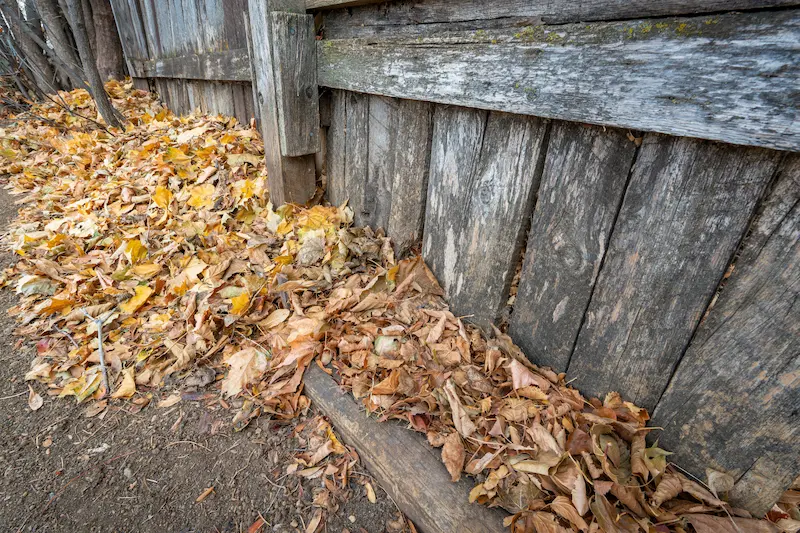When fall rolls around in North Texas, we finally get a break from the blazing summer heat. The evenings cool off, the air feels crisp, and the holidays are just around the corner. But while we’re pulling out sweaters and planning bonfires, our fences could use a little TLC too.
It might not seem like fall is a big deal for your fence—after all, we don’t get blizzards or frozen ground like folks up north—but this season is actually one of the best times to do preventative maintenance. A few simple tasks now can keep your fence standing strong all winter long and save you from expensive repairs later.
Let’s walk through everything you can do this fall to keep your fence in great shape, whether it’s wood, iron, or a mix of both.
Why Fall Fence Maintenance Matters in North Texas
Here in the Arlington and Grand Prairie area, our weather keeps fences on their toes. Hot summers dry out wood, metal parts expand and contract, and the occasional cold snap or ice storm can really test a fence’s strength.
By fall, you’ve likely got some wear and tear from months of UV exposure, shifting soil, and backyard activity. Taking care of those issues now—before the wetter months hit—helps prevent moisture from sneaking into cracks or joints where it can cause rot, rust, or warping.
Think of it like an oil change for your car. A little maintenance now keeps everything running (and looking) good for years.
Step 1: Clear Away the Debris
Start with the basics: clean up around your fence.
All those fallen leaves, grass clippings, and mulch that pile up at the base of your fence? They trap moisture, which leads to rot in wood fences and corrosion in metal ones.
Here’s what to do:
- Rake or sweep away leaves and debris along the fence line.
- Trim back plants or shrubs that are touching or leaning on the fence—this helps airflow and prevents trapped moisture.
- Check for vines creeping up boards or rails. They might look charming, but they pull moisture right into the wood and can loosen fasteners over time.
If you’ve got a sprinkler system, make sure it’s not spraying directly onto your fence. Even treated wood can start to break down with constant water exposure.
Step 2: Give It a Good Cleaning
Once the debris is gone, it’s time for a quick clean. You don’t need anything fancy—a mild soap, a soft brush, and a garden hose will do the trick.
For wood fences, this step removes dirt, mildew, and pollen buildup. For metal fences, it helps remove dust and grime that can hide small rust spots.
If you spot any green or black discoloration (especially on the shaded side of your fence), mix up a simple solution of water and white vinegar. Spray it on, let it sit for 10–15 minutes, and rinse it off. That’ll kill mold and mildew without harming plants or grass.
Avoid using bleach or harsh chemicals—they can strip your wood and leave behind residue that makes it harder for stain or sealant to stick later.
Step 3: Inspect for Summer Damage
Now that everything’s clean, take a slow walk around your yard and inspect your fence from top to bottom.
Summer in Texas can be brutal on fences. The constant UV exposure fades color and weakens finish, while dry soil and high heat can cause boards or posts to shift.
Look for:
- Loose or missing nails, screws, or brackets
- Boards that are cracked, warped, or split
- Posts that lean or feel unstable
- Faded stain or bare spots where the finish has worn off
- Rusty hinges or gate latches
If your fence has metal components, run a rag along the posts or rails. If it comes away with orange or brown dust, that’s early rust—time to sand and touch up those areas before it spreads. This is where calling the professionals like us to come help can be of great value, we can replace or sand it down without taking off too much.
Step 4: Repair Before Winter
Once you’ve spotted the issues, fix them while the weather is still pleasant.
Fall is the perfect time for small repairs because the cooler air helps wood stay dry and makes staining or sealing more effective. Tighten screws, replace warped boards, and swap out rusted hardware before the first freeze.
If you’ve got a section that’s sagging or leaning, don’t ignore it. That’s a sign the post base might be loose or rotted. Resetting a post or replacing a panel now is way easier (and cheaper) than waiting until it collapses under the weight of ice or strong winds.
If you’re not confident about doing repairs yourself, that’s where a professional fence contractor like M&C Fence DFW comes in. We can assess structural issues, replace damaged sections, and make sure everything is reinforced for the winter ahead before the ground freezes.
Step 5: Protect the Wood with Stain or Sealant
If your fence hasn’t been re-stained or sealed in the last couple of years, fall is the ideal time to do it.
The cooler temperatures and lower humidity mean the product dries evenly and bonds better to the wood. That protective barrier keeps moisture out and helps prevent the cracking, splitting, and warping that often show up after a cold, wet winter.
Here’s how to do it:
- Make sure the fence is clean and dry.
- Use a brush or sprayer to apply the stain evenly, covering edges and joints.
- Let it cure for at least 24–48 hours before watering your yard or letting pets run against it.
For extra protection, choose a stain with UV and water resistance. It’ll protect against both sun fading and moisture intrusion.
If your fence is painted instead of stained, now’s a good time to touch up chips and cracks. Any exposed wood can absorb moisture and start to rot beneath the paint.
Step 6: Lubricate Gates and Hardware
As temperatures drop, metal parts like hinges and latches can stiffen or squeak.
A quick spritz of lubricant (WD-40 or similar) on gate hinges and locks helps them swing freely through winter. Also, check that all latches close securely—sometimes gates sag slightly after a long summer of use, and a quick adjustment keeps them operating smoothly.
Step 7: Special Care for Iron or Metal Fences
If you have a wrought iron or steel fence, fall maintenance looks a little different.
Metal fences are sturdy, but they’re also prone to rust—especially if paint or coating has worn off. Look for:
- Scratches, chips, or thin spots in the coating
- Rust starting near welds or joints
- Loose fasteners or bolts
To keep your fence in great shape:
- Sand off small rust spots and repaint with a rust-resistant primer and enamel paint.
- Clean the fence with mild detergent and rinse well.
- Apply a light wax or protective coating to repel moisture.
Keeping your metal fence in top condition not only prevents expensive repairs later—it keeps it looking sleek and adds curb appeal year-round.
Step 8: Trim Nearby Plants and Trees
This one’s easy to overlook, but it makes a big difference.
Branches and shrubs that rub against your fence during windy days can scrape away paint or stain. Overhanging trees can drop leaves or sap that trap moisture against wood.
In fall, trim everything back a few inches so there’s space between your plants and your fence. It helps air circulate and keeps your fence drier, which means less mold, rot, and insect activity.
Step 9: Plan for the Occasional Freeze
We might not get snow every winter in North Texas, but when we do, it’s usually a mess—freezing rain, sleet, or a thin layer of ice that weighs down fences and gates.
To prepare:
- Tighten any loose hardware so panels don’t shift under weight.
- Make sure drainage is good around your fence line (no standing water).
- Keep rock or gravel at the base of wooden posts so they don’t sit in wet soil.
If we do get a freeze, avoid knocking ice off your fence—it can crack boards or damage finish. Let it melt naturally when temps rise again.
Step 10: Consider a Professional Checkup
You don’t have to handle every bit of maintenance yourself. A professional inspection can identify things you might miss—like loose footings, internal rot, or corrosion below the surface.
At M&C Fence DFW, we can do a seasonal tune-up that includes:
- Tightening and aligning gates
- Replacing hardware
- Sealing or staining
- Checking post stability
- Recoating metal surfaces
It’s a small investment that pays off big when your fence lasts years longer and avoids major repairs down the road.
Creating a Year-Round Fence Maintenance Plan
Fall might be the perfect time for major upkeep, but a good fence maintenance plan is something you can follow all year.
Here’s a simple schedule to keep your fence looking great:
Spring:
- Wash off pollen, dirt, and mildew.
- Check for rot or loose boards after winter weather.
- Inspect for sun damage or drying wood.
- Touch up stain if color has faded.
Fall:
- Deep clean and clear leaves.
- Repair and reseal before cold weather.
Winter:
- Watch for frost cracks or ice buildup.
- Keep debris and snow away from the base.
By spreading maintenance throughout the year, each step takes less time—and your fence stays in better condition no matter what Texas weather throws at it.
Protect Your Fence, Protect Your Investment
Your fence does more than mark property lines—it adds privacy, security, and beauty to your home. With just a few hours of fall maintenance, you can keep it looking sharp and standing strong through the winter and beyond.
Whether you’ve got a classic cedar fence, a sturdy metal one, or a combo of both, taking a little time this season to clean, inspect, and protect it will extend its lifespan and keep your yard looking great.
If you’d rather skip the hassle, M&C Fence DFW has you covered. We can inspect, repair, and re-seal your fence to make sure it’s ready for cooler weather—so you can enjoy your backyard this fall without worrying about what’s happening along the fence line.


